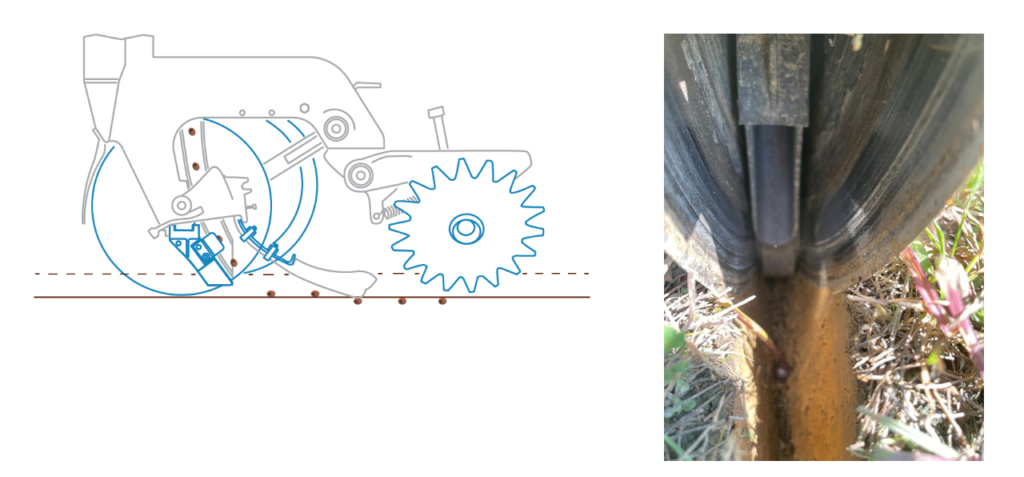By Ethan Begle, Sales & Technical Service
Most of the popular seed openers used today are the same concept of using a disc to create a slot for the seed to reach the proper depth. Anyone who has ran or evaluated no-till seeding today realizes that getting a seed to emerge is not always guaranteed successful. The design and intention behind the components of the seed opener can make a big difference in a successful crop stand. The planter needs to cut the residue, place the seed, firm the seed into moisture, and close the furrow completely.

Exapta has stood behind John Deere, Kinze, Harvest International, and White (now Fendt) as the no-till opener of choice. They are mostly the same design, and the aftermarket has lots of options to improve the shortfalls on these openers in no-till. (Sharp opening blades are the most important factor no matter which disc opener you prefer.) The biggest advantage with these is the seed placement is the most accurate (currently) in all conditions. The gauge wheel position is where the accuracy starts. Being right at the point where the blades are exiting the soil and turning upwards, the gauge wheels pin down the soil to keep the furrow walls perfectly intact. The furrow walls are the only thing to guide the seed to the bottom after it exits the seed tube. If there is not a well-defined furrow, the seed can be set off to the side where it gets tucked under the sidewall. Not only can this cause issue with the seed growing sideways, but it can cause it to miss the seed firmer and not get firmed into moisture.

You need to have sidewall compaction but there can be too much, especially critical when it’s wet. The gauge wheels need to firmly touch the ground to maintain depth and to prevent blowout. New high-speed planters today have had to widen the distance between opener blades to make enough room for the larger brush belt and speed tubes. This will make closing much more difficult as the furrow is a little wider. Another point the OEMs have missed is where the seed tube release point is. It’s still too far back where the blades exit the soil. With Precision Planting speed tubes being straighter there is an opportunity for seed release further forward at the center of the opener blades. This would greatly help pre-mature sidewall collapse, especially on Case planters.
A common question has always been, “Do you offer anything for Case IH planters?”. In no-till conditions we have run into issues with the early riser openers. Offset opener blades in theory will hairpin less due to a leading blade that does the cutting while the offset blade acts like a rolling seed boot. However, there are some key details in design that need to be exactly right with the angle and how they contact each other. The use of RID gauge wheels allows too much sidewall to lift which due to the seed drop point being too far back and the gauge being too far forward to hold the sidewall in place. The sidewall can then crumble into the furrow before the seed reaches the bottom causing uneven depth and emergence. The two-stage closing system, while it works well in dry soils, tends to struggle to close and over packs in heavier, moist, no-till soils. There are simply too many little details that add up to make these openers consistently work well in all conditions.
When it comes to closing the furrow, standard design wants to use the closing wheels to firm the soil around the seed. This eliminates the need for a firmer touching the seed, but this is only successful in loose or tilled soil conditions. In structured no-till soils with roots still intact, the soil does not easily crumble and pack around the seed. This is why a firmer is a must have attachment, as the seed getting pushed into the bottom of the furrow puts it into moisture for much more even emergence of every seed. Also, this takes the pressure off the closing wheels of trying to perfectly pack and crumble the soil around the seed so there are no air pockets. Loose soil above the seed makes for a much easier time poking out of the soil. Using a packer wheel behind the closing wheels to lightly firm the soil shut can be helpful in dry conditions to prevent the furrow from drying out too quickly, but a firmer will make this much less of a problem.
Every planting season can be a range of conditions from too dry to too wet. It is helpful to be able to adjust the planter through it all, but with what’s currently available, some designs are easier to adjust and make work in this range. The most important thing is to always get out and dig to verify whatever opener you are using is cutting residue, placing the seed correctly, and closing the furrow well. There are many more details to this topic, and we would be happy to talk more about your situation.
Call 785-820-8000 to discuss how we can help make your planter perform better, or to chat about the content in this newsletter.
